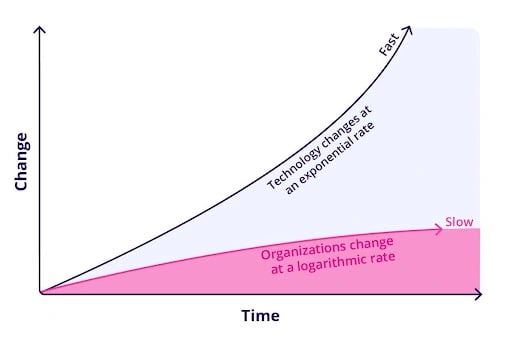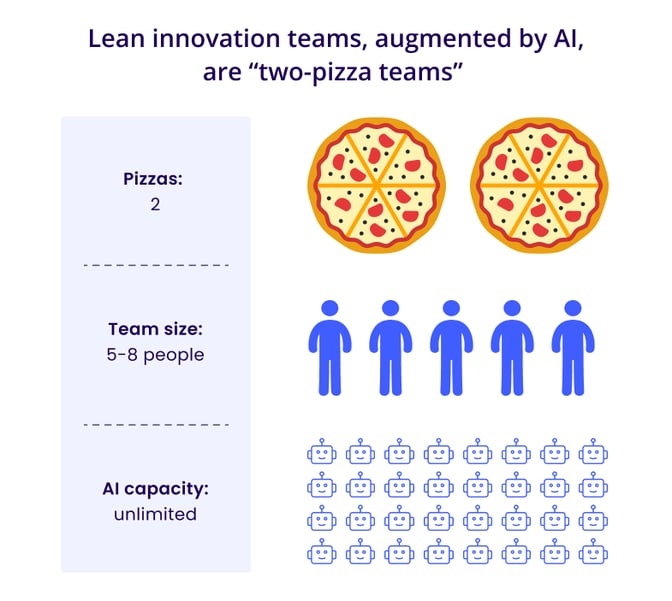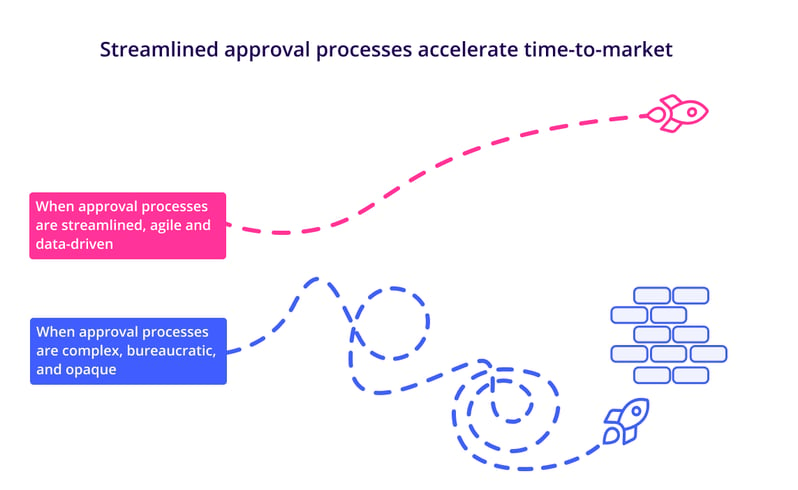Scan the covers of best-selling books on innovation, and many of them focus on culture as a major driver of innovation success. Concepts of lean and agile. Startup and experimentation mindsets. Advice to fail fast and fail forward.
The message is clear: to perpetually innovate, especially beyond initial success, requires companies to foster a culture of leaner, faster, and smarter practices in their innovation endeavors. And in today’s world, this is increasingly achieved by underpinning culture with intelligence and technology.
This blog explores best practices for reducing overheads, bureaucratic hurdles, and complex approval processes. From augmenting teams with artificial intelligence (AI) to empowering decision-makers with the right data, innovation culture today is about more than just embracing change; it's about striking a balance between lean teams and robust capabilities, achieving speed without losing direction, and being steered by data over organizational bias.
Microsoft's cultural overhaul
We know from Martec’s Law that organizations change slower than the pace of technological advancement. This is because culture—values, attitudes, behaviors, and standards—is deeply ingrained and developed over time, meaning they must, in some cases, undevelop gradually as well.

So, what does this look like in practice? To answer this question, let’s look at an example from tech giant Microsoft:
In the mid-2010s, Microsoft was large and stable enough to coast as a fast follower. But instead, it moved from a comfortable position of defense to one of startup-like offense. In the process, it shed its cash cows (including the Windows operating system along with other once-prized investments) freeing up capacity to work on new projects. It also began buying up and partnering with leading tech companies in new categories, including video games (Activision Blizzard), social media (LinkedIn), and, most notably—most disruptively—generative AI (OpenAI).
But these actions didn’t just occur out of the blue. They were accompanied by a strategic and cultural overhaul at Microsoft, spearheaded by its CEO Satya Nadella, who took over in 2014. Nadella immediately set to work reorienting the company. This entailed flattening internal hierarchies and reducing bureaucracy for its engineers, allowing them to focus on the innovative work they’d been hired for. The company sponsored the “world’s largest” hackathon, emphasizing speed through collaboration, and began attracting fresh talent with its revised image and a lofty new goal to “empower every person and every organization on the planet to achieve more.”
To shift from the mindset of an enterprise and incumbent to that of a startup, Microsoft infused more customer-centricity into its development. It updated its KPIs from sales metrics to usage metrics. And then, it established real-time dashboards to monitor user engagement, directing developers' attention toward features and functionalities actually utilized by customers.
In essence, Microsoft began acting like a much leaner and faster company than it had exemplified in its previous few decades. And it all began with cultural change—how it organized its teams, elevated projects, and made decisions.
Leaner: AI-augmented teams
When it comes to lean teams, how lean is too lean? And how big is too bureaucratic? Now, an example from another tech giant, Amazon:
In a concept popularized by Amazon founder and CEO Jeff Bezos, the optimal size for lean teams is often described as "two-pizza teams," where the team size is small enough to be fed with just two pizzas. Hunger levels and pizza diameter aside, this is a metaphor for keeping innovation teams small enough to minimize overhead and bureaucracy while maximizing efficiency and impact.
So, how do organizations reconcile the focus on lean, two-pizza teams with the conventional belief that a broader network of contributors leads to more ideas and, ultimately, a more robust innovation pipeline?
One way to reconcile these approaches is to create flexible structures and processes that allow lean teams to partner with external contributors, such as customers, partners, and industry experts. By leveraging open innovation platforms, organizations can tap into a broader community's collective wisdom and creativity while maintaining the focus and efficiency of lean teams. Like Microsoft did with its acquisitions and hackathons, for example.
More recently, AI has emerged as a tool to augment lean team dynamics and further enhance innovation processes. By integrating AI technologies into the innovation process, lean teams can generate insights that may otherwise be overlooked. They can make more informed decisions and automate repetitive tasks to achieve even more than large teams with manual or analog processes:
- Intelligence: Innovation teams using AI-based methodologies for signal selection are significantly better at separating noise from news than their counterparts, with nearly half of the signals identified by AI being both novel and relevant.
- Creativity: Current AI language models like ChatGPT demonstrate higher creative potential than humans. When measuring divergent thinking (a common indicator of creativity), AI outperforms humans across three dimensions: fluency, originality, and elaboration.
- Productivity: Teams that completely integrate AI into their workflows and continually interact with the technology show significant productivity gains—completing 12% more tasks, 25% faster, and with more than 40% higher quality compared to traditional teams.

Amidst this AI revolution, lean teams should still emphasize diverse perspectives, deep expertise, and cross-functional collaboration. Human ingenuity, empathy, and experience remain invaluable assets in innovation. But alongside these human qualities, AI is a force multiplier. It’s a team member many times over, continuously learning, improving, accelerating, with not even a slice of the pizza consumed.
Faster: Streamlined approval processes
Inefficient and opaque approval processes hinder a company's ability to innovate and adapt to market demands. Such processes often result in delayed decision-making, stifled creativity, and missed opportunities. Teams may become frustrated and demotivated, leading to decreased morale and productivity.
Moreover, the rigidity of these processes can impede agility, making it difficult for companies to respond swiftly to changes in the competitive landscape or customer preferences. Ultimately, companies risk falling behind their more agile competitors, losing market share, and failing to capitalize on emerging opportunities.
On the other hand, streamlined approval processes, undertaken in flattened, empowered teams, can reduce time to market by a remarkable 40% while increasing customer satisfaction by 30% and profitability by 25%, according to a study by McKinsey & Company.
One exemplary case of streamlined approval processes can be found in the practices of SpaceX, Elon Musk's aerospace company. Known for its ambitious projects and rapid development cycles, SpaceX already grapples with stringent approvals from external regulators like the FAA. The last thing it needs is a similarly lengthy and complex internal bureaucracy. Therefore, the company has adopted a culture of agile approval processes, prioritizing speed without compromising safety or quality to move its innovations swiftly from prototypes to implementation.
At SpaceX, decision-making is decentralized, with cross-functional teams empowered to make critical decisions autonomously. Rather than relying on cumbersome hierarchical structures, SpaceX emphasizes direct communication and collaboration among team members, allowing for rapid feedback and iteration.
Furthermore, SpaceX leverages technology to streamline approval workflows.
- A centralized innovation operating system for managing all information, ideas, and projects promotes consistency and clarity in approval processes. Decision-makers gain a 360-degree view of relevant data, enabling them to quickly spot patterns, trends, and potential issues.
- Automated approval workflows ensure that decisions are made swiftly and consistently, eliminating bottlenecks and delays. Customizing these workflows to match internal phase gates further ensures that approval processes align with specific organizational requirements.
- Real-time data analytics and visualization tools such as Dashboards, Kanban Boards, and Lists provide decision-makers with immediate insights into project KPIs, progress, risks, and dependencies, facilitating informed and agile decision-making.

Fortunately, implementing efficient approval processes doesn’t require rocket science. It begins with internal culture—fostering collaboration, communication, and a drive for continuous improvement. And when these cultural changes are augmented by technology, habits are reinforced, manual work is minimized, and approval workflows are transformed to support innovation.
Smarter: An end-to-end Innovation OS
The ITONICS Innovation Operating System unites intelligence, teamwork, and technology, empowering organizations to innovate smarter. By seamlessly integrating AI to augment creativity, providing teams with relevant data for informed decision-making, and streamlining processes for efficiency, the Innovation OS enables your company to unlock its full innovation potential.
The Innovation OS promotes a leaner, faster, and smarter approach to innovation. Through collaboration, communication, and a relentless pursuit of continuous improvement, teams are empowered to work more effectively and drive impactful innovation initiatives. Powered by AI and built around best practices in lean, agile, and open innovation, our software transforms innovation culture, accelerating time-to-market and setting you up for sustainable growth.




/venture-clienting-for-dual-use-startups-guidelines-full.webp??&width=900&height=450&name=venture-clienting-for-dual-use-startups-guidelines-full.webp)